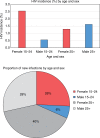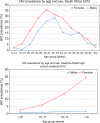Adolescent girls and young women: key populations for HIV epidemic control
- PMID: 25724504
- PMCID: PMC4344544
- DOI: 10.7448/IAS.18.2.19408
Adolescent girls and young women: key populations for HIV epidemic control
Abstract
Introduction: At the epicentre of the HIV epidemic in southern Africa, adolescent girls and young women aged 15-24 contribute a disproportionate ~30% of all new infections and seroconvert 5-7 years earlier than their male peers. This age-sex disparity in HIV acquisition continues to sustain unprecedentedly high incidence rates, and preventing HIV infection in this age group is a pre-requisite for achieving an AIDS-free generation and attaining epidemic control.
Discussion: Adolescent girls and young women in southern Africa are uniquely vulnerable to HIV and have up to eight times more infection than their male peers. While the cause of this vulnerability has not been fully elucidated, it is compounded by structural, social and biological factors. These factors include but are not limited to: engagement in age-disparate and/or transactional relationships, few years of schooling, experience of food insecurity, experience of gender-based violence, increased genital inflammation, and amplification of effects of transmission co-factors. Despite the large and immediate HIV prevention need of adolescent girls and young women, there is a dearth of evidence-based interventions to reduce their risk. The exclusion of adolescents in biomedical research is a huge barrier. School and community-based education programmes are commonplace in many settings, yet few have been evaluated and none have demonstrated efficacy in preventing HIV infection. Promising data are emerging on prophylactic use of anti-retrovirals and conditional cash transfers for HIV prevention in these populations.
Conclusions: There is an urgent need to meet the HIV prevention needs of adolescent girls and young women, particularly those who are unable to negotiate monogamy, condom use and/or male circumcision. Concerted efforts to expand the prevention options available to these young women in terms of the development of novel HIV-specific biomedical, structural and behavioural interventions are urgently needed for epidemic control. In the interim, a pragmatic approach of integrating existing HIV prevention efforts into broader sexual reproductive health services is a public health imperative.
Keywords: HIV prevention; adolescent girls; prevention interventions; young women.
Figures
References
-
- UNAIDS. Global report: UNAIDS report on the global AIDS epidemic 2013 [cited 2014 Aug 14] Available from: http://www.unaids.org/en/media/unaids/contentassets/documents/epidemiolo....
-
- UNAIDS. 2008 Report on the global AIDS epidemic [cited 2014 Aug 14] Available from: http://www.unaids.org/en/media/unaids/contentassets/dataimport/pub/globa....
-
- Anderson SJ, Cherutich P, Kilonzo N, Cremin I, Fecht D, Kimanga D, et al. Maximising the effect of combination HIV prevention through prioritisation of the people and places in greatest need: a modelling study. Lancet. 2014;384:249–56. - PubMed
-
- Barnabas RV, Celum C. Bending the curve: maximising impact with focused HIV prevention. Lancet. 2014;384:216–7. - PubMed
-
- Shisana O, Rehle T, Simbayi LC, Zuma K, Jooste S, Zungu N. Cape Town: HSRC Press; 2014. South African national HIV prevalence, incidence and behaviour survey, 2012. - PubMed
Publication types
MeSH terms
Grants and funding
LinkOut - more resources
Full Text Sources
Medical




